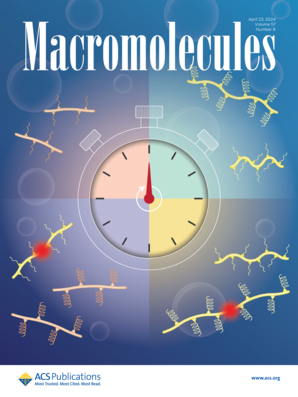等规聚丁烯溶剂加速i - i - i相变的起源
IF 5.1
1区 化学
Q1 POLYMER SCIENCE
引用次数: 0
摘要
采用傅里叶红外光谱(FTIR)、WAXD和原子力显微镜(AFM)等技术系统研究了等规聚丁烯(iPBu)在二甲苯和自然环境中的i - i相变过程。研究发现,在自然环境中时效过程中,I型晶体的成核需要很长时间,通常需要几个小时以上,而在二甲苯中,I型晶体的成核是立即发生的,通常在几分钟甚至几秒钟内。此外,对iPBu II型单晶相变过程的AFM原位研究表明,iPBu II型单晶在二甲苯中相变时的生长速度约为61±1.7 nm/min,比自然环境老化时的生长速度(0.28±0.05 nm/min)快218倍。由此可见,二甲苯中I型晶体的快速成核和快速生长导致iPBu的I - I - I相转变加速。此外,发现在二甲苯中通过I - I - I相获得的I型iPBu单晶的厚度与其II型前驱体的厚度相似,而在自然环境中获得的I型晶体的厚度比原始II型晶体减少了约15%。这说明二甲苯在单晶表面使链折叠环垂直扩展,导致与晶体内链连接的部分链段堆积成规则的晶体,这弥补了晶体在链方向上的收缩,导致二甲苯转化后结晶度略有提高(约5%)。这些结果清楚地揭示了溶剂加速iPBu i - i相变的机理。本文章由计算机程序翻译,如有差异,请以英文原文为准。

The Origin of Solvent-Accelerated II–I Phase Transition of Isotactic Poly(1-butene)
The II–I phase transition process of isotactic poly(1-butene) (iPBu) in xylene and the natural environment has been systemically investigated by FTIR, WAXD, and AFM techniques. It is found that while the nucleation of form I crystals during aging in a natural environment takes a long time, normally over hours, the nucleation of form I crystals in xylene occurs immediately, generally in minutes or even in seconds. In addition, AFM in situ study on the phase transition process of iPBu form II single crystals demonstrates that the growth rate of form I iPBu crystals during phase transition in xylene is about 61 ± 1.7 nm/min, which is 218 times faster than that during aging in a natural environment (0.28 ± 0.05 nm/min). It is thus clear that the quick nucleation and fast growth of form I crystals in xylene result in an accelerated II–I phase transition of iPBu. Moreover, it is found that the thickness of form I iPBu single crystals obtained through the II–I phase in xylene is similar to that of its form II precursor, whereas that of the form I crystal attained in a natural environment decreases by around 15% compared to the original form II crystal. This suggests that xylene vertically expands the chain fold loops at the single-crystal surface and results in the packing of some chain segments in connect with the chains in crystals into regular crystals, which compensates for the contraction of crystals in chain direction and leads to a slight (approximately 5%) increase of crystallinity after transformation in xylene. These results clearly shed more light on the mechanism of the solvent-accelerated II–I phase transition of iPBu.
求助全文
通过发布文献求助,成功后即可免费获取论文全文。
去求助
来源期刊

Macromolecules
工程技术-高分子科学
CiteScore
9.30
自引率
16.40%
发文量
942
审稿时长
2 months
期刊介绍:
Macromolecules publishes original, fundamental, and impactful research on all aspects of polymer science. Topics of interest include synthesis (e.g., controlled polymerizations, polymerization catalysis, post polymerization modification, new monomer structures and polymer architectures, and polymerization mechanisms/kinetics analysis); phase behavior, thermodynamics, dynamic, and ordering/disordering phenomena (e.g., self-assembly, gelation, crystallization, solution/melt/solid-state characteristics); structure and properties (e.g., mechanical and rheological properties, surface/interfacial characteristics, electronic and transport properties); new state of the art characterization (e.g., spectroscopy, scattering, microscopy, rheology), simulation (e.g., Monte Carlo, molecular dynamics, multi-scale/coarse-grained modeling), and theoretical methods. Renewable/sustainable polymers, polymer networks, responsive polymers, electro-, magneto- and opto-active macromolecules, inorganic polymers, charge-transporting polymers (ion-containing, semiconducting, and conducting), nanostructured polymers, and polymer composites are also of interest. Typical papers published in Macromolecules showcase important and innovative concepts, experimental methods/observations, and theoretical/computational approaches that demonstrate a fundamental advance in the understanding of polymers.
 求助内容:
求助内容: 应助结果提醒方式:
应助结果提醒方式:


